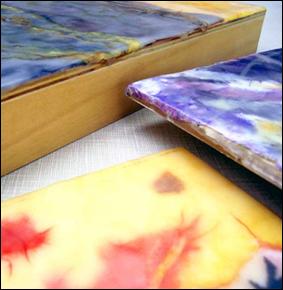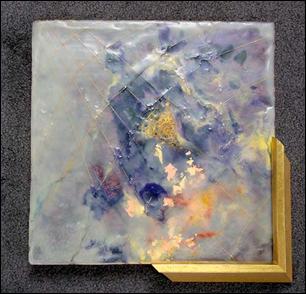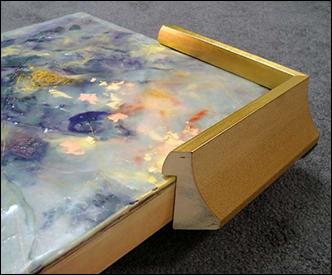 Photo 1
Photo 1
Encaustic on cradled box, birch panel and 8-ply rag
Genesis by Gwen Walker-Strahan
Painting on assorted substrates help dictate how an encaustic painting might be framed. We all know that a cradled panel serves as its own frame presentation if the sides are painted, stained, polished or waxed. But even a box can be traditionally framed as long as the color, style and shape—also called profile—is right for the art.
 Photo 1
Photo 1
Encaustic on cradled box, birch panel and 8-ply rag
Genesis by Gwen Walker-Strahan
The 12x12" mixed media embedded encaustic art by Gwen Walker-Strahan in photo 2 was completed and on display at the gallery displayed as a box with polished unstained sides and no frame. After six months it came home and she lived with it for another year. Finally she decided it needed a frame to finish it off. The deep swan profile gold leaf moulding was selected to pick up the flakes of leaf in just under the top layer of wax and help unify the work (photo 2). The warm red based gold leaf in this frame nicely picks up the same base colors in the art. Be careful never to use a cool gold on a warm gold painting or the visual clash will never allow it to meld. So, the two basic things to watch out for when selecting a frame profile is for it to work with the colors in the art and it must be deep enough to accommodate the depth of the substrate—in this case the box (photo 3). The addition of the frame added another $125 to the package but the piece sold at the next showing.
 Photo 2
Photo 2
A red base gold leaf frame picks up the colors of the embedded leaf.
 Photo 3
Photo 3
The swan profile flairs out at the bottom for slight added visual width and is deep enough to handle the box.
The concept behind all framing is to "enhance and protect". By matching colors within the art and/or repeating an element or pattern—as with the gold in the sample—the frame is unified with the art and enhances, but should never overpower it. A raw sided box can draw unwanted attention to the sides sometimes feeling they were neglected or unfinished, that's is not good either. A frame also protects the art from possible damage. The frame moulding must be taller than all points of the face of the painting so in the event the painting lands face down it will be protected from actually coming in contact with that surface. Notice the ½" height above the painting in photo 3 that protects all embedded portions of this painting. The frame must also be deep enough to handle the full depth of the box, never letting any part of the painting stick out the back of the frame. This allows for a dust cover and/or proper hardware while the painting will still fit flush against the wall.
END
Copyright © 2013 Chris A Paschke
For more articles on mounting basics look under the mounting section in Articles by Subject.
There is a special section in the library for all past IEA Framing Matters articles from Wax-On!
Additional information on all types of mounting is found in:
The Mounting and Laminating Handbook, Second Edition, 2002,
The Mounting And Laminating Handbook, Third Edition, 2008 and
Creative Mounting, Wrapping, And Laminating, 2000 will teach you everything you need to know about getting the most from your dry mount equipment and materials as an innovative frame designer.
All books are available from Designs Ink Publishing through this website.
Chris A Paschke, CPF GCF
Designs Ink
Designs Ink Publishing
785 Tucker Road, Suite G-183
Tehachapi, CA 93561
P 661-821-2188
chris@designsinkart.com